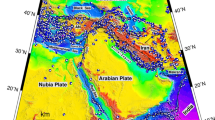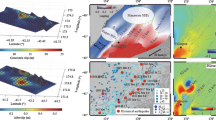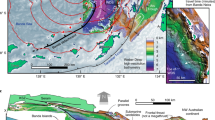Abstract
This work presents new seismological and Global Positioning System (GPS) results aimed at understanding the nature and rate of strain associated with the opening of the Suez rift that separates the Sinai sub-plate from the African plate. The Sinai sub-plate has played a significant role in the tectonic evolution of the northern Red Sea and the Eastern Mediterranean region. Most small, moderate and large earthquakes occur within belts associated with the geologically documented borders of this sub-plate including the Dead Sea fault (DSF) system in the east, the Cyprian arc (CA) in the north, and the Suez rift (SR) to the southwest. The DSF and CA are well defined; however, the SR is only partially defined. Earthquake foci distribution supports the idea that the SR is seismically active, and this earthquake activity cannot be ignored throughout the kinematics evaluation of northern Red Sea region. The earthquake activity is relatively higher in the southern part of the SR and gradually decreases northward. The high seismicity is mainly attributed to the presence of the Sinai triple junction. Earthquake focal mechanisms in the SR are dominated by oblique normal faulting with left-lateral strike-slip components on NW trending fault planes consistent with regional kinematics. The extensional semi-principal stress axes derived from fault plane solutions are oriented NNE-SSW in good agreement with the current stress field obtained from borehole breakouts along the SR as well as results from GPS surveying. Recent survey-mode GPS observations provide evidence for coherent northerly motion of the Sinai sub-plate that varies between 2 and 5 mm/yr. Moreover, strain analysis indicates that the southern SR is dominated by extension while its northern segment is characterized by constriction, inconsistent with earthquake focal mechanisms and regional tectonic models. The overall northward motion of the Sinai sub-plate indicates that slab-pull rather than ridge-push is the dominant force controlling regional kinematics. Based on the low rate of extension and lack of oceanic crust, the SR can be considered an incipient plate boundary between the Sinai sub-plate and the Nubian plate.
Similar content being viewed by others
References
Abdel-Gawad M., 1969. New evidence of transcurrent movement in Red Sea area and petroleum implications. AAPG Bull., 53, 1466–1479.
Badawy A., 1996. Seismicity and Kinematic Evolution of the Sinai Plate. PhD Thesis, Eötvös Loránd University, Budapest, Hungary, pp. 115.
Badawy A., 2005a. Present-day, seismicity, stress field and crustal deformation of Egypt. J. Seismol., 9, 267–276.
Badawy A., 2005b. Seismicity of Egypt. Seismol. Res. Lett., 76, 149–160.
Badawy A. and Horváth F., 1999a. Recent stress field of the Sinai subplate region. Tectonophysics, 304, 385–403.
Badawy A. and Horváth F., 1999b. Seismicity of the Sinai sub-plate region: kinematic implications. J. Geodyn., 27, 451–468.
Badawy A. and Horváth F., 1999c. The Sinai sub-plate and tectonic evolution of the northern Red Sea region. J. Geodyn., 27, 433–450.
Ben-Menahem A. and Aboodi E., 1971. Tectonic patterns in the northern Red Sea region. J. Geophys. Res., 76, 2674–2689.
Ben-Menahem A., Nur A. and Vered M., 1976. Tectonics, seismicity and structure of the Afro-Eurasian junction, the breaking of an incoherent plate. Phys. Earth. Planet. Inter., 12, 1–50.
Chenet P.Y., Colletta B., Letouzey J., Desforges G., Qusset E. and Zaghloul E.A., 1987. Structures associated with extensional tectonics in the Suez rift. Geol. Soc. London Spec. Pub., 28, 551–558.
Cochran J.R., 1983. A model for the development of the Red Sea. AAPG Bull., 67, 41–69.
Colletta B., LeQuellec P., Letouzey J. and Moretti I., 1988. Longitudinal evolution of the Suez rift structure (Egypt). Tectonophysics, 153, 221–233.
Courtillot V., Armijo R. and Tapponnier P., 1987. The Sinai triple junction revisited. Tectonophysics, 141, 181–190.
Freund R., 1965. A model of the structural development of Israel and Adjacent areas since upper Cretaceous times. Geol. Mag., 102, 189–205.
Fuji Y., 1997. Estimation of continuous distribution of Earth’s strain in the Kanto-Tokai district, Central Japan, with the aid of least squares collocation. An Advanced Lectures on Geodesy and Seismology in Egypt. Bulletin of NRIAG (Special Issue). 97–126.
Garfunkel Z. and Bartov Y., 1977. The tectonics of the Suez rift. Geol. Surv. Israel. Bull., 71, pp. 44.
Girdler R.W., 1990. The Dead Sea transform fault system. Tectonophysics, 180, 1–13.
Hugentobler U., Schaer S. and Fridez P., 2001. Bernese GPS Software Version 4.2 Documentation. Astronomical Institute, University of Bern, Bern, Switzerland.
Joffe S. and Garfunkel Z., 1987. Plate kinematics of the circum Red Sea, a re-evaluation. Tectonophysics, 141, 5–22.
Le Pichon X. and Francheteau J., 1978. A plate tectonic analysis of the Red Sea-Gulf of Aden area. Tectonophysics, 46, 369–406.
Le Pichon X., Francheteau J. and Bonnin J., 1976. Plate Tectonics. Developments in Tectonics 6., Elsevier, Amsterdam, The Netherlands.
Mahmoud S., Reilinger R., McClusky S., Vernant P. and Tealeb, 2005. GPS evidence for northward motion of the Sinai block: implications for E. Mediterranean tectonics. Earth Planet. Sci. Lett., 238, 217–227.
Mart Y. and Hall J.K., 1984. Structural trends in the northern Red Sea. J. Geophys. Res., 89(B13), 11352–11364.
Marzouk I., 1988. Study of Crustal Structure of Egypt Deduced from Deep Seismic and Gravity Data. PhD Thesis, Hamburg University, Germany, pp. 118.
McClusky S., Reilinger R., Mahmoud S., Ben Sari D. and Tealeb A., 2003. GPS constraints of Africa (Nubia) and Arabia plate motions. Geophys. J. Int., 155, 126–138.
McKenzie D., 1970. Plate tectonics of the Mediterranean region. Nature, 220, 239–243.
McKenzie D., 1972. Active tectonics of the Mediterranean region. Geophys. J. R. Astron. Soc., 30, 109–185.
McKenzie D., Davies D. and Molnar P., 1970. Plate tectonics of the Red Sea and East Africa. Nature, 226, 243–248.
Moretti I. and Colletta B., 1987. Spatial and temporal evolution of the Suez rift ubsidence. J. Geodyn., 7, 151–168.
Moustafa A.R., 1996. Internal structure and deformation of an accommodation zone in the northern part of the Suez rift. J. Struct. Geol., 18, 93–107.
Patton T.L., Moustafa A.R., Nelson R.A. and Abdin A.S., 1994. Tectonic evolution and structural setting of the Suez rift. In: Landon S.M. (Ed.), Interior Rift Basins. American Association of Petroleum Geologists Memoir, 59, 7–55.
Picard L., 1966. Thoughts on grabens system of the Near East. Geol. Surv. Can. Pap., 66-14, 22–32.
Reilinger R., McClusky S., ArRajehi A., Mahmoud S., Rayan A., Ghebreab W., Ogubazghi G. and Al-Aydrus A., 2006a. Geodetic constraints on rupturing of continental lithosphere along the Red Sea. MARGINS Newsletter, 17, 17–21.
Reilinger R., McClusky S., Vernant P., Lawrence S., Ergintav S., Cakmak R., Ozener H., Kadirov F., Guliev I., Stepanyan R., Nadariya M., Hahubia G., Mahmoud S., Sakr K., ArRajehi A., Prilepin D., Al-Aydrus A., Prilepin M., Guseva T., Evre E., Dmitrotsa A., Filikov S.V., Gomez F., Al-Ghazzi R. and Karam G., 2006b. GPS constraints on continental deformation in the Africa-Arabia-Eurasia continental collision zone and implication for the dynamics of plate interactions. J. Geophys. Res., 111, B0541, doi: 1029/2005JB004051.
Riguzzi F., Pietratonio G., Piersanti A. and Mahmoud S., 2006. Current motion and short-term deformations in the Suez-Sinai area from GPS observations. J. Geodyn., 41, 485–499.
Robson D.A., 1971. A detailed magnetic survey of the southern Red Sea. Geol. Jahrb., D13, 131–153.
Said R., 1962. The Geology of Egypt. Elsevier, Amsterdam, The Netherlands, pp. 396.
Salamon A., Hofstetter A., Garfunkel Z. and Ron H., 1996. Seismicity of the eastern Mediterranean region: perspective from the Sinai sub-plate. Tectonophysics, 263, 293–305.
Salamon A., Hofstetter A., Garfunkel Z. and Ron H., 2003. Seismotectonics of the Sinai subplate-the eastern Mediterranean. Geophys. J. Int., 155, 149–173.
Steckler M., Lavier L., Feinstein S., Kohn B. and Eyal M., 1998. Pattern of mantel thinning from subsidence and heat flow measurements in the Gulf of Suez: evidence for the rotation of Sinai and along-strike flow from the Red Sea. Tectonics, 17, 903–920.
Suetsugu D., 1998. Practice on Source Mechanism. IISEE Lecture Note. University of Tsukuba, Tsukuba, Japan, pp. 104.
Tapponnier P. and Armijo R., 1985. Seismotectonics of northern Egypt. Terra Cognita, 5, 171.
Tarr A., 1974. World Seismicity Map. U.S. Geol. Surv., Reston, VA, G74119 (Single sheet map).
Trimble N.L., 2003. Geomatics Software’s User Manual. Trimble Navigation Limited, Sunnyvale, U.S.A.
Wdowinski S., Bock Y., Baer G., Prawirodirjo L., Becher N., Naaman S., Kanfo R., Forrai Y. and Melzer Y., 2004. GPS measurements of current movements along the Dead Sea fault J. Geophys. Res., 109, doi: 10.1029/2003JB002640.
Westaway R., 1994. Present-day kinematics of the Middle East and eastern Mediterranean. J. Geophys. Res., 99, 12071–12090.
Youssef M.I., 1968. Structural pattern of Egypt and its interpretation. AAPG Bull,, 52, 601–614.
Author information
Authors and Affiliations
Corresponding author
Rights and permissions
About this article
Cite this article
Badawy, A., Mohamed, A.M.S. & Abu-Ali, N. Seismological and GPS constraints on Sinai sub-plate motion along the Suez rift. Stud Geophys Geod 52, 397–412 (2008). https://doi.org/10.1007/s11200-008-0028-9
Received:
Revised:
Accepted:
Published:
Issue Date:
DOI: https://doi.org/10.1007/s11200-008-0028-9




